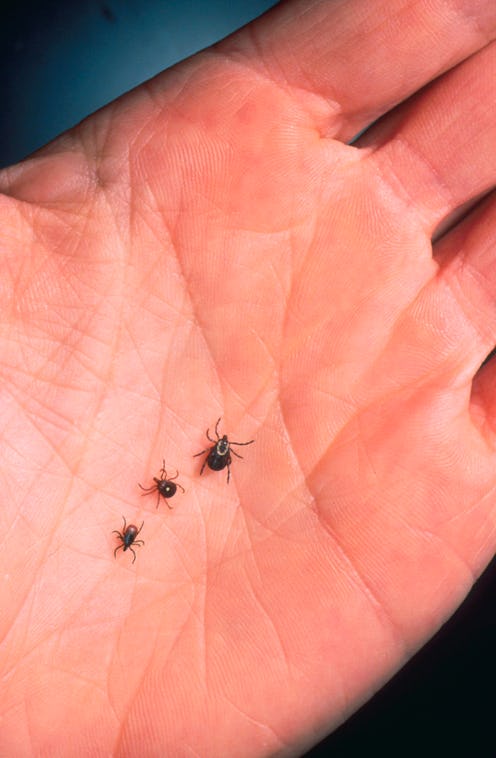
Planning to take a hike in the woods this summer? Be on the lookout for a new threat in the form of a tiny tick that seems to have supernatural powers. If you get bitten, Lone Star tick symptoms can mimic food poisoning, or a severe allergic reaction. And, the Lone Star tick could force you to become a vegetarian, because one result of getting bitten by this insect is developing an allergy to red meat. Cue Mulder and Scully. While it sounds like it's straight out of the X-Files, this is actually not a science fiction storyline.
"You're walking through the woods, and that tick has had a meal of cow blood or mammal blood," Cosby Stone, an allergy and immunology fellow at Vanderbilt University, told National Geographic. "The tick, carrying Alpha-Gal, bites you and activates your allergy immune system."
What's more is that you might not even realize you're been infected until you get violently ill at a backyard barbecue after chowing down on a ribeye or hamburger. This is because your body creates Alpha-Gal antibodies, and rewires itself to fight Alpha-Gal sugar molecules, which are prevalent in red meat.
The ticks are mostly found in the Midwest, East Coast, and in southern parts of the United States. While not everyone who is bitten will develop the red-meat allergy, there are other illnesses you can contract from the ticks. If you think you've been bitten by the Lone Star tick, here are the symptoms you need to watch out for.
1Hives
If you develop hives, and have ruled out all other causes, it's possible you've been bitten by the Lone Star tick, named for a mark on its body that resembles the state of Texas.
The hives, also known as Southern Tick-Associated Rash Illness, can resemble the rash common in the early stages of Lyme disease. Other symptoms you may have STARI include fatigue, fever, headache, and joint and muscle pain. The condition can usually be cleared up with antibiotics, according to the University of Florida's Entomology & Nematology department.
2Vomiting & Diarrhea
The symptoms of being bitten by the Lone Star tick can be similar to food poisoning, but may also be accompanied by hives, and shortness of breath a few hours after eating red meat, Stone explained to National Geographic.
"There's a time delay in the reaction," said Stone, which accounts for why some people don't always immediately realize they're have a reaction. "It [the Alpha-Gal] has to first travel through your gastrointestinal tract to be released. Hours later, patients wake up with hives, shortness of breath, vomiting, and diarrhea."
3Fever & Body Aches
Developing a fever or body aches after hiking in the woods could be a sign of ehrlichiosis, a bacterial illness transmitted by ticks that causes flu-like symptoms, according to the University of Florida's Entomology & Nematology department.
If you think this is why you're feeling under the weather, don't try to ride it out. The Mayo Clinic noted that the condition can be treated with antibiotics if you seek medical attention right away.
4Shortness Of Breath
If you begin to have difficulty breathing after eating red meat, it might be best to head to the hospital. If you can't take a full breath, and there is no other reasonable cause, don't take any chances with your life.
5Skin Ulcers & Swollen Glands
Some people who are bitten by the Lone Star tick develop tularemia, a bacterial infection that can spread to the lungs. Signs that you might have this can include an ulcer at the site of the tick bite, swollen lymph nodes in the neck, ulcers in the mouth, a fever, and sore throat, according to the Mayo Clinic, which suggests seeing a doctor as soon as possible if you think you've been exposed to ticks, and are exhibiting these symptoms.
6Chills
If your t-bone steak dinner results in a night of cold sweats, or chills, you may have been bitten by the Lone Star tick. If it happens to you exclusively after eating red meat, and has happened more than once, it's time to see a doctor.
"Most patients don't know what they have," Stone told National Geographic. Some people have several episodes before they realize what's happening, and Stone noted that repeated exposure to the Lone Star tick can intensify the symptoms.
7Dizziness & Blurred Vision
Suddenly becoming dizzy, or experiencing blurred vision, could be a sign of dangerously low blood pressure, which has been documented in some people who were bitten by the Lone Star Tick.
"Some patients have had to be given life support because their blood pressure is so low that they're in eminent danger of dying," Stone told National Geographic.
Unfortunately, there is no vaccine for the Lone Star tick, but you can get treatment to help manage the symptoms, and if you're one of the people who develops the Alpha-Gal allergy, you'll have to avoid red meat. Your pets can be bitten too, though it's not known if the food allergy extends to animals.
Experts suggest entering the woods in affected areas with caution, using insect repellents containing DEET or permethrin, wearing long pants, long sleeves and socks, and performing tick checks — on both yourself and your pets — after outdoor activity. Make sure your pets are on a flea and tick preventative medication; your vet can recommend one.
Or, perhaps instead of acting out the book or movie Wild this summer, stay home and read it, or watch the film instead. Seriously, Mulder and Scully can show up anytime now.